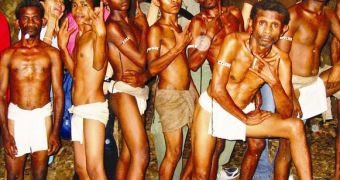Pygmies make the smallest human race, but they are not dwarfs. Amongst those of pure blood, men have an average height of just 1.45 m (4 ft 10 in) and women of 1.33 m (4 ft, 1in), still they do not represent a dwarf variant of the Black Africans. Their body proportions are the same with those of other humans, that's why their heads look large compared to the rest of the body. But otherwise, they are perfectly proportioned, whereas dwarfs are deformed.
This is an ancient race and only the Khoi-San people (bushmen), now restricted to South Africa, are the oldest among existent Homo sapiens races. They are closer to the so-called Asian Blacks, who inhabit much of India, New Guinea, Melanesia and Australia (Aborigines) and have many genes in various populations from South Asia and Polynesia.
Pygmies were among the first people to had left Africa in order to colonize Asia, and at one time, they inhabited large areas of south Asia. Modern relict populations of the pygmy race are found not only in Africa, but also in many parts of southern Asia: Aeta and Batak in Philippines, Semang in Malaya, Mani in Thailand, the Andamanese tribes from the Andaman archipelago, Rampasasa from Flores island and many pygmy tribes inhabiting the mountains of New Guinea or in Vanuatu archipelago.
A new theory, published in "Proceedings of the National Academy of Sciences", puts the small height of the pygmies on a very short lifespan, even as little as 16 years in some pygmy communities. This could have been forced by evolutionary pressure on pygmy women, to stop growing at an early age and use energy otherwise employed for growing in producing babies at a younger age.
"The idea is that [pygmies] have to stop growing earlier, because when you start reproducing-at least for women-all the energy you would put in growth is put into reproduction", said lead author Andrea Migliano, a postdoctoral fellow at Clare College, Cambridge, UK.
This theory challenges the previous idea that pygmies' small size was determined by poor nutrition. Migliano pointed that some of the world's tallest people (like Kenya's Maasai and Samburu) commonly experienced poor nutrition, and pygmies subjected to better nutrition didn't grow taller, as the short height is a strong genetic trait. The research team focused on the Philippines pygmies, the Aeta and the Batak.
"Mortality is high in these communities because the populations are ravaged by easily preventable diseases, such as measles and chicken pox. Their diets are also poor, making them more susceptible to illness", said Migliano.
In the '80s, James Eder, an anthropologist at Arizona State University in Tempe, had showed that Batak women entered menopause as early as 28 or 29 years old. Similar theories to the new ones have been applied for explaining the difference in size between mammals species, like elephants and mice. But the new research applies this to humans and points that pygmies are a strong proof of the evolution of Homo sapiens, opposed to creationism.
"There is this idea that evolution should not apply for humans. I am sure we are still adapting to our environment. But saying we are adapting to our environment doesn't say that the pygmies are fine. They are adapting to the worst situation in the world", said Migliano.

 14 DAY TRIAL //
14 DAY TRIAL //